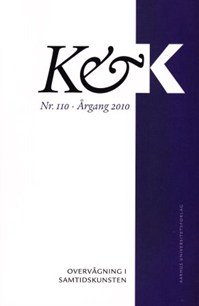“THIS IS THE TIME. AND THIS IS THE RECORD OF THE TIME”
DOI:
https://doi.org/10.7146/kok.v38i110.15773Nøgleord:
Haywood, overvågning, ArendtResumé
THIS IS THE TIME. AND THIS IS THE RECORD OF TIME
Today’s extensive use of databases for storing identifying biometric and genetic information raises several questions on the relations between bodies, tech nology, information, power, human rights and personal integrity. While an individualistic understanding of the human being is inadequate as a way of approaching this complex of problems, we are also confronted with the challenge not to dissolve the subject, thus overlooking the fragility of our condition and the ways in which our bodies are being encroached. The present article attempts to meet this double challenge.
Starting with the short story Fantomina: or Love in a Maze, written by Eliza Haywood during the early 18th century, and with a discussion on some relations between fiction, power and surveillance, the article investigates contemporary ways in which bodies are being inscribed in laws and captured in the trap of scription when used as proofs of identity. The article analyzes questions of identification in their historical complexity, as well as the patterns that are played out by powers of recording, operating with some continuity over the past centuries.
It is also suggested that so-called bodily freedoms and rights, as well as integrity, could gain in critical significance by considering the “betweenness” – the inter-est of Hannah Arendt – and the ways in which our existence presupposes the other (understood as both the world and the others conditioning us). Opposing the individualistic tradition, the law understood as a boundary does not, thus, enclose independent individuals in sovereign possession of themselves beyond time and space; instead, the boundary gains its significance in relation to an opaque who in continuous becoming.
Downloads
Publiceret
Citation/Eksport
Nummer
Sektion
Licens
Tidsskriftet følger dansk ophavsret.





